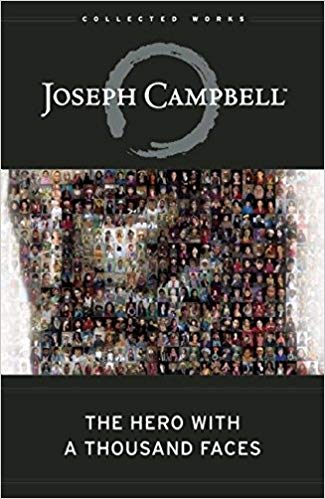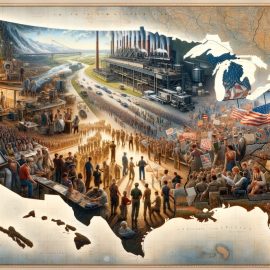

This article is an excerpt from the Shortform summary of "The Hero with a Thousand Faces" by Joseph Campbell. Shortform has the world's best summaries of books you should be reading.
Like this article? Sign up for a free trial here .
What’s a monomyth? How many monomyth stages are there? What are they? Where did they come from?
The monomyth is a template that shows the hero’s journey common in many myths, folktales, and religions. The monomyth is an expression from James Joyce but was popularized by Joseph Campbell in The Hero With a Thousand Faces.
We’ll dive into the monomyth definition above and cover the 17 stages of monomyths and what happens to the hero in each.
17 Stages of Campbell’s Monomyth
The Hero With a Thousand Faces is an exploration of the power of myth and storytelling, from the ancient world to modern times, and spanning every human culture across the world. All peoples, and indeed, all individuals, make sense of the world they live in and grapple with the experience of living by telling stories. Myths are the foundation of all human physical and intellectual pursuits, be they religious, economic, social, or cultural, because these myths tell us who we are and what destinies we are here to fulfill.
The Monomyth
The core structure of mythology is called the monomyth. Campbell’s monomyth involves three rites of passage—separation, initiation, and return. From the myths of the ancient Egyptians and the medieval Arthurian legend to the folk-tales of the native Maoris of New Zealand, the pattern of the hero’s journey usually follows this cycle: a separation from the world he or she has always known (embarking on the quest), gaining some spiritual or other-worldly power, and a return in which they share the boon of the new power with humanity.
There are familiar beats throughout world-legend—the call to action; the initial reluctance of the hero; the aid of a supernatural helper; the crossing of the threshold into the world of the unknown; union with the mother-goddess; the slaying of the father-god; the return to the land of the living; and the sharing of the ultimate boon.
The Mythological Template: Monomyth
Although the settings and plots of myths vary widely across time and space, from the Homeric poems of ancient Greece to the enlightenment of the Buddha in India to the Christian story of the birth and resurrection of Christ, they all share a certain core set of themes, a standard template. This template is the mythological adventure of the hero—someone who sets out on a journey, often with the help of a sage guide and allies along the way, overcomes obstacles, and achieves some sort of transformation which he or she then shares with the world. This can either be the sharing of a literal bounty (bringing abundance and prosperity back to a hungry and impoverished community) or a deeper, more spiritual redemption of a wayward and fallen people.
The point in space and time where divine wisdom is imparted to the physical world is known as the World Navel. It is the center of the universe, the spot from which all life grows: it is the portal between our world and the world of the divine. It is represented in a variety of ways across religious and mythological traditions and throughout time—it is Rome in Catholicism, Mecca in Islam, or the Immovable Spot in the Buddha legend—but the idea is always the same.
This transformation of the hero comes from tapping into a source of deep spiritual wisdom, which is often revealed to have been within the soul or psyche of the hero from the beginning. Thus, the archetypal hero’s journey involves a spiritual awakening, an attainment of some piece of the gods. We see this, for example, in the story of Prometheus, who ascended to heaven and stole fire from the gods, which he then imparted to the world. We also see this in the myth of Jason, who sailed through the Clashing Rocks and defeated a dragon to obtain the Golden Fleece, which enabled him to win back his throne from a usurper.
Monomyth Stage #1: The Call to Adventure
In the first part of the monomyth, we meet our hero, our “man of destiny,” and witness their call to adventure. The call to adventure can come about through chance, even a mistake or blunder, which introduces the hero to a hidden world of possibility, guided by mysterious forces which the hero will come to understand through the course of their journey.
Monomyth Stage #2: Refusal to the Call
A common feature of the monomyth is the hero’s refusal of the call, an initial reluctance to follow the steps of their destiny. In folk tales and myths across the world and throughout history, this refusal amounts to a selfish impulse to give up one’s narrow, immediate interests in the pursuit of spiritual awakening or even the salvation of the universe. In psychoanalytic terms, the refusal represents the clinging to infantile needs for security. Thus, the mother and father are the figures preventing true growth and transformation as the ego fails to develop and embrace the world outside the nursery. The refusal can have grave consequences, both for the hero and for the wider world.
Monomyth Stage #3: Supernatural Aid
Some heroes respond to the call immediately. They are then guided along the path of adventure by a supernatural helper, as part of their first steps along the hero-journey. This helper is the personification of destiny. Often, this figure takes the form of an old man or old woman, like the fairy godmother, wizard, shepherd, smith, or woodsman figures of European fairy tales. But it can also take on other forms, like that of the Virgin Mary in many Christian saints legends from the Middle Ages. In the ancient mythology of Egypt and Greece, this figure was the boatman or ferryman, the conductor of souls to the afterworld—Thoth in Egyptian lore and Hermes-Mercury in Greek legend.
Monomyth Stage #4: Crossing the Threshold
With this aid and guidance in hand, the hero sets off on their adventure until they come to a point where they are further away from the world of comfort and familiarity than they have ever been before. Ahead of them lies the danger of the unknown. On an individual level, this aspect of the heroic monomyth parallels the dangers and uncertainties of growing out of childhood and away from the protection of one’s parents.
Monomyth Stage #5: Belly of the Whale
Next comes one of the most potent symbols of the hero’s death and rebirth—the common motif of the hero being inside the belly of the whale. This belly symbolizes the womb (also a temple); the darkness within represents death; and the hero’s emergence parallels the act of birth (or rebirth).
Monomyth Stage #6: The Road of Trials
Now we move into the main action of the myth, wherein the hero undergoes a series of trials and tests, with the aid of their supernatural helper. The hero might also discover the existence of a benevolent, omnipotent power guiding all things in the universe. In mythology, the hero’s journey often requires entering the underworld or the land of the dead.
Monomyth Stage #7: The Meeting With the Goddess
The ultimate adventure often comes through the marriage of the hero to the goddess. The goddess is the epitome of beauty and represents the feminine ideal in all its aspects—mother, sister, mistress, and bride. She is the ultimate hope for the hero, assuring him that he will be returned to the blissful world he knew before the journey. This is the classic maternal goddess figure, the “good” mother.
Monomyth Stage #8: Woman as Temptress
But there is also a dark twist on this theme. For there is a “bad” mother figure, a goddess who attempts to either harm the hero, spurn his advances, hamper him in his quest, or tempt him into desire.
Monomyth Stage #9: Atonement With the Father
In keeping with the Oedipal themes that run so strongly throughout so much mythology, the figure of the father-god is often a fearsome ogre whom the hero must either overcome or reconcile with. This echoes the psychological rivalry and subconscious hatred that Freudian psychoanalysts believe so many children (particularly young men) feel toward their fathers. The father is the archetypal enemy, because he is the original intruder who enters the infant’s life after the serenity and union with the mother (goddess) in utero. In Freudian terms, one cannot live a peaceful and productive emotional life as an adult without resolving these deep-rooted childhood conflicts.
Monomyth Stage #10: Apotheosis
After conquering their fears, the hero at last achieves their long-sought enlightenment. They have shattered the bounds of consciousness and reached a divine state. Mythological and religious traditions throughout history and across the world teach us that this power lives within us all—we achieve it through our own herohood.
Monomyth Stage #11: The Ultimate Boon
In this stage of the hero’s journey, the hero achieves their goal and is reborn as a superior being. This is often shown by the ease with which the hero is now able to obtain the things that they seek. In the Irish legend of the Prince of the Lonesome Island, the hero is rewarded by being able to eat from a table with food that automatically replenishes, freeing him from hunger and want—he has achieved limitless bounty, indestructible life, the Ultimate Boon.
Monomyth Stage #12: Refusal of the Return
Sometimes, mythology records a hero unwilling to return to the world. Just as they may have refused the initial call to adventure, so they may refuse their duty to return home and bestow their newfound wisdom upon the rest of humanity. Even the Buddha, after his victory at the Tree of Enlightenment, doubted if it was even possible to bring the joy of true enlightenment to other mortals. It is tempting for the hero to simply turn away from the world and reside forever in Paradise.
Monomyth Stage #13: The Magic Flight
If the hero has won the Ultimate Boon through trickery or manipulation of the gods, their return home may be marked by a chase as the gods seek to regain the elixir that has been stolen from them. Sometimes, the hero will use decoys to delay or confuse the pursuer.
Monomyth Stage #14: Rescue From Without
Sometimes, the hero will require aid from a third party in order to return home from the realm of the supernatural. The hero, indeed, may need to be rescued himself.
Monomyth Stage #15: The Crossing of the Return Threshold
Now, at last, the hero returns to the ordinary world with their divine boon in hand. The hero’s journey has been an exercise in uniting the world of the unknown with the world of the known—for the two are mirror images, opposite sides of the same coin. The challenge now is to communicate to the ordinary world the wisdom and enlightenment that the hero has learned in their quest to the land of the gods. One of the hardest things for the hero to accept is the reality of the sorrows and banalities of ordinary human existence.
Monomyth Stage #16: Master of Two Worlds
The true hero is one who can move seamlessly between the two worlds, without destroying or compromising either. We see this in the Transfiguration of Christ from the New Testament, in which the body of Jesus becomes radiant with the glory and grace of God.
Monomyth Stage #17: Freedom to Live
The individual must embrace their own self-annihilation. These figures of ascetic self-denial are represented across the world’s religious traditions, from the wandering mendicants of the East, to the Wandering Jew and itinerant monks of medieval Europe. The manifestations vary, but the concept is universal.
———End of Preview———

Like what you just read? Read the rest of the world's best summary of "The Hero with a Thousand Faces" at Shortform . Learn the book's critical concepts in 20 minutes or less .
Here's what you'll find in our full The Hero with a Thousand Faces summary :
- How the Hero's Journey reappears hundreds of times in different cultures and ages
- How we attach our psychology to heroes, and how they help embolden us in our lives
- Why stories and mythology are so important, even in today's world






